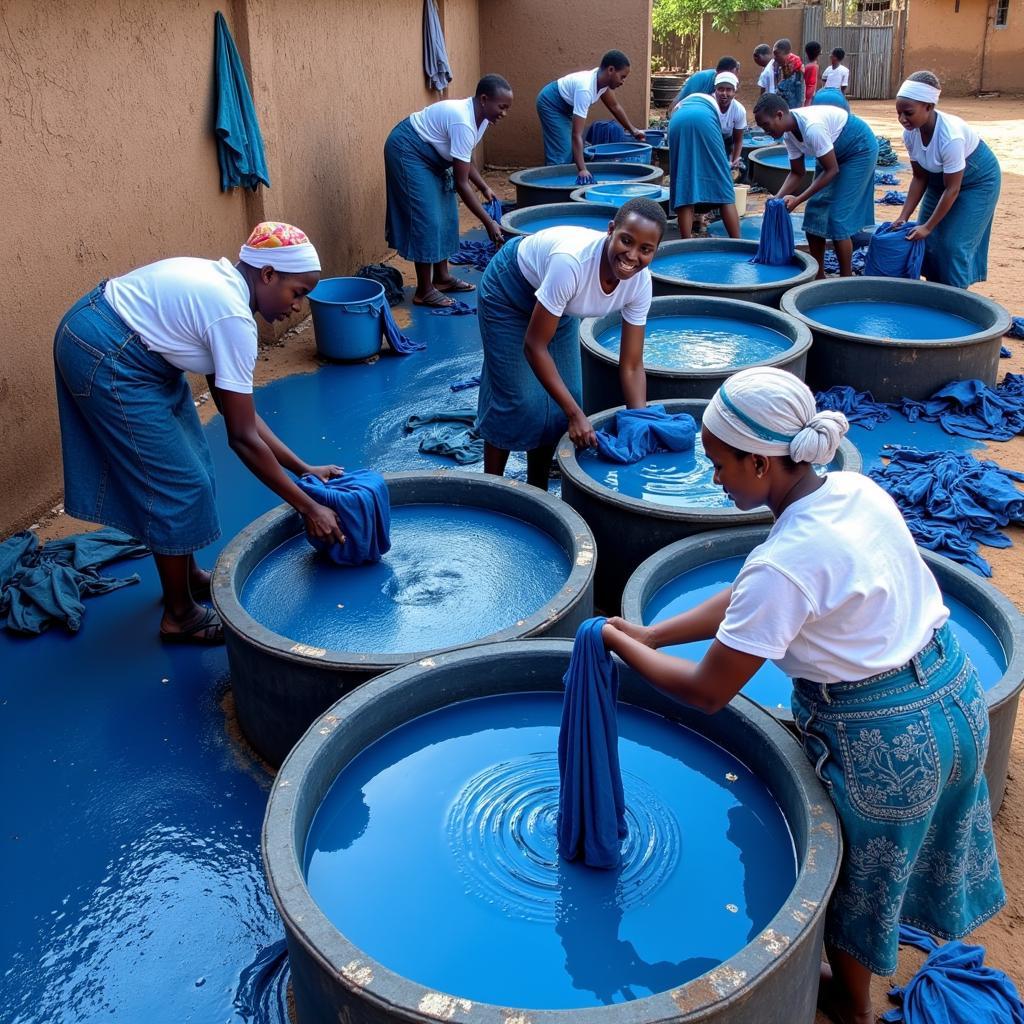Exploring African Embroidery Techniques
African Embroidery Techniques are a vibrant tapestry of cultural expression, storytelling, and artistic skill. From the intricate geometric patterns of North Africa to the bold, colorful designs of the southern regions, each stitch tells a story, connecting generations and preserving traditions. This article will delve into the rich world of African embroidery, exploring its diverse forms, historical significance, and contemporary applications.
See some of the most stunning African dress designs for ladies.
A Journey Through the Continent’s Stitches
African embroidery is far from a monolithic entity. Each region, and often each community, boasts unique styles, materials, and techniques. North African embroidery, influenced by Islamic art, often features intricate geometric patterns, utilizing silk and metallic threads on fine fabrics. Moving south, we encounter a burst of color and texture, with techniques like appliqué and chain stitch bringing bold designs to life. West African embroidery often incorporates symbolic motifs representing proverbs, historical events, or spiritual beliefs.
What are some common African embroidery techniques?
Some common African embroidery techniques include appliqué, chain stitch, and couching. Appliqué involves stitching pieces of fabric onto a base material to create intricate designs. Chain stitch, a looped stitch, is used for outlining and creating decorative patterns. Couching secures threads or cords to the fabric’s surface, adding texture and dimension. These techniques, often combined, create the distinctive character of African embroidery.
How is African embroidery used in contemporary fashion?
African embroidery has made a significant impact on the global fashion scene. Designers are incorporating traditional techniques and motifs into contemporary clothing, accessories, and home décor. From haute couture runways to local markets, the vibrant colors and intricate designs of African embroidery are captivating audiences worldwide. You can also see some beautiful examples in this collection of African fashion 2016.
The Cultural Significance of African Embroidery
Beyond its aesthetic appeal, African embroidery holds deep cultural significance. It serves as a powerful medium for storytelling, preserving historical narratives and cultural values. Embroidered garments often denote social status, age, or marital status within a community. Furthermore, the process of creating embroidery is often a communal activity, fostering social bonds and passing down knowledge through generations. Check out these beautiful African attire dresses pictures.
Learning and Preserving African Embroidery Techniques
Today, numerous organizations and individuals are dedicated to preserving and promoting African embroidery techniques. Workshops and educational programs provide opportunities to learn these intricate skills, ensuring that the rich traditions continue to thrive. The growing interest in sustainable and ethical fashion has also fueled a renewed appreciation for handcrafted textiles, further supporting the artisans who carry on these time-honored traditions.
Conclusion
African embroidery techniques are a testament to the continent’s rich cultural heritage and artistic ingenuity. From the intricate geometric designs of the north to the bold, vibrant patterns of the south, each stitch tells a story, connecting us to the past and inspiring the future. By learning about and appreciating these diverse forms of embroidery, we can help preserve a valuable art form and celebrate the creativity of African artisans. Explore further the fascinating world of African applique.
FAQ
-
What materials are commonly used in African embroidery?
Common materials include cotton, wool, silk, raffia, and beads. -
What are some common motifs found in African embroidery?
Common motifs include geometric patterns, animals, plants, and symbols representing proverbs or spiritual beliefs. -
How can I learn African embroidery techniques?
You can find online tutorials, workshops, and classes offered by cultural centers and organizations dedicated to preserving traditional crafts. -
Where can I purchase authentic African embroidery?
You can find authentic pieces at craft markets, fair trade shops, and online marketplaces specializing in handcrafted goods. -
What is the significance of color in African embroidery?
Colors often hold symbolic meanings related to social status, spirituality, or natural elements. -
How is African embroidery being modernized?
Designers are incorporating traditional techniques and motifs into contemporary fashion and home decor. -
What is the best way to care for African embroidered items?
Care instructions vary depending on the materials used. Generally, hand washing or dry cleaning is recommended.
Common Situations & Questions
-
I’m looking for a unique gift with cultural significance. African embroidery offers a wide range of beautiful and meaningful gifts, from wall hangings to clothing and accessories.
-
I want to learn a new craft that connects me to a different culture. Learning African embroidery can be a rewarding experience, allowing you to explore a rich artistic tradition.
-
I’m a fashion designer looking for inspiration and unique textile techniques. African embroidery techniques can provide a wealth of inspiration for innovative and culturally rich designs.
Further Exploration
Explore more about African textile arts and cultural heritage. Discover the rich history and symbolism behind these beautiful creations.
For any inquiries or assistance regarding African embroidery or related cultural topics, please don’t hesitate to contact us. Call: +255768904061, Email: [email protected], or visit us at Mbarali DC Mawindi, Kangaga, Tanzania. Our customer service team is available 24/7.

